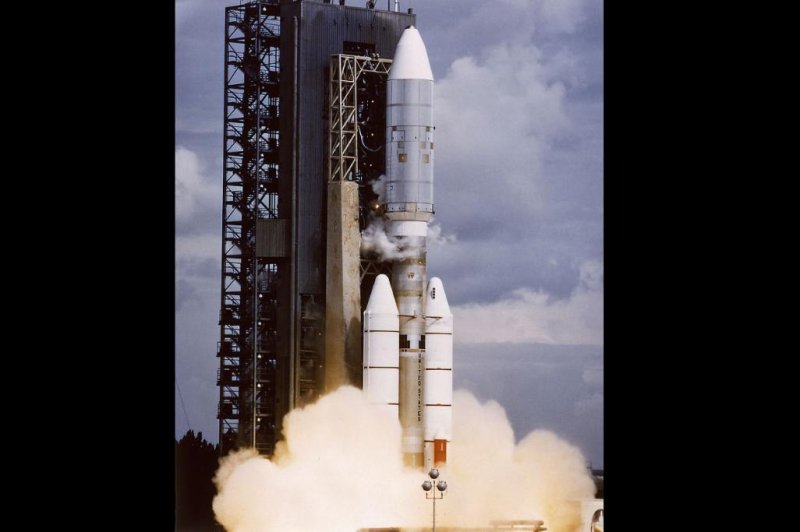Even after 45 years, Voyager 1 and Voyager 2 are still communicating with Earth as they explore interstellar space.

Voyager 2 lifts off at the Kennedy Space Center on Merritt Island, Fla., on August 20, 1977. The probe was launched a couple weeks before Voyager 1 and ultimately became the second-farthest man-made object from the Earth. Photo courtesy NASA
Aug. 19 (UPI) -- Forty-five years ago, NASA launched the first part of its most ambitious deep space mission in its history -- a spacecraft called Voyager 2, which is still communicating with scientists on Earth at a distance of more than 12 billion miles away.
Voyager 1 and Voyager 2 are both in interstellar space. In fact, they are one of only five space probes from Earth that have left the solar system.
Because of planetary alignment and the trajectory needed for its mission, Voyager 2 actually launched first on Aug. 20, 1977. Voyager 1 followed on Sept. 5, and the two space probes began charting the far reaches of the galaxy.
The two probes are still operating as NASA's longest international mission, and are expected to keep operating for at least a few more years before they finally run out of power.
Saturday will mark 45 years since the start of the mission.
Even though NASA has achieved a number of major victories in space, such as the Apollo moon landings and dozens of space shuttle missions, the Voyager spacecrafts are still fondly revered by scientists and the space-loving public.

Voyager 1 and Voyager 2, both launched in 1977, are graphically represented in their positions several years ago at the edge of the heliosphere, the barrier the sun creates around the planets in the solar system. Image courtesy NASA
The resilient machines have even become part of popular culture, fictionally appearing in a number of television programs and films. A fictional Voyager probe was a major plot point in the first Star Trek film in 1979 and one was responsible for bringing a benign alien life form to Earth in the 1984 film Starman.
"The Voyagers have continued to make amazing discoveries, inspiring a new generation of scientists and engineers," Suzanne Dodd, Voyager project manager at NASA's Jet Propulsion Laboratory in California, said in a statement Wednesday.
"We don't know how long the mission will continue, but we can be sure that the spacecraft will provide even more scientific surprises as they travel farther away from Earth."
Following their launches, both probes became part of a "grand tour" to explore the outer planets in great detail for the first time, including Jupiter and Saturn, and to beam back data about the solar system's largest plants and their moons. Voyager 1, which was moving faster, ultimately overtook Voyager 2 and reached the outer planets first.
Later in the mission, Voyager 2 became the first -- and to date still the only -- spacecraft to fly exceptionally close to the two outermost planets, Uranus in 1986 and Neptune in 1989.
On its way out of the solar system in 1990, Voyager 1 turned its onboard camera around to take a snapshot of all the planets except Mercury, which was out of view. The image is now known as the "family portrait." At the time, the craft was almost 4 billion miles from Earth.
"Today, as both Voyagers explore interstellar space, they are providing humanity with observations of uncharted territory," Linda Spilker, Voyager's deputy project scientist at JPL, said in a statement.
"This is the first time we've been able to directly study how a star, our sun, interacts with the particles and magnetic fields outside our heliosphere ... and providing key information for future missions."
As Voyager 2 conducted its flybys, Voyager 1 was first to reach the boundary of the heliosphere, the protective bubble created by the sun's magnetic field and the outward flow of solar wind.
Both of the space probes captured stunning images of all the planets beyond the Earth, including many of their moons, and gathered surprising data about a lot of the celestial bodies.
For example, the Voyagers discovered that Enceladus, one of Saturn's moons, has a vast salt-water ocean beneath its surface and likely hydrothermal vents -- conditions that are exceptional for creating life. Large geysers emerging from the moon´s surface clued scientists to this fact.
Decades later in 2012, Voyager 1 reached the boundary of the heliosphere and exited the solar system and Voyager 2 followed in 2018.
Upon its exit, Voyager 1 discovered that the bubble-like heliosphere blocks about 70% of cosmic rays or energetic particles created by exploding stars.
Both Voyager probes are powered by radioisotope thermoelectric generators that contain plutonium, which gives off heat that is then converted into electricity to power the equipment. In a sign of the times, they also each carry an eight-track tape player to record and transmit data -- about 38,000 times slower than modern 5G Internet speeds.
No comments:
Post a Comment